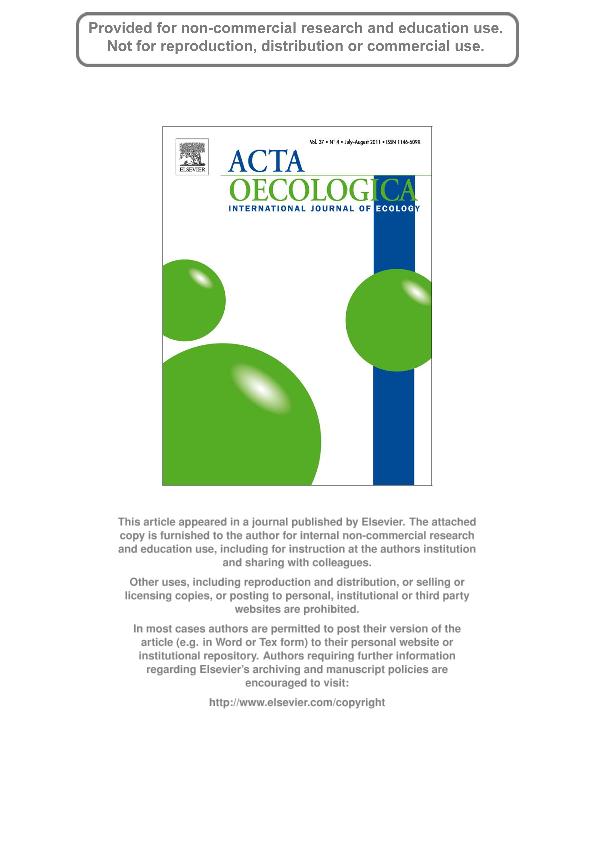Mostrar el registro sencillo del ítem
dc.contributor.author
Carilla, Julieta

dc.contributor.author
Aragón, Myriam Roxana

dc.contributor.author
Gurvich, Diego Ezequiel

dc.date.available
2019-03-20T21:09:39Z
dc.date.issued
2011-04
dc.identifier.citation
Carilla, Julieta; Aragón, Myriam Roxana; Gurvich, Diego Ezequiel; Fire and grazing differentially affect aerial biomass and species composition in Andean grasslands; Gauthier-Villars/Editions Elsevier; Acta Oecologica; 37; 4; 4-2011; 337-345
dc.identifier.issn
1146-609X
dc.identifier.uri
http://hdl.handle.net/11336/72164
dc.description.abstract
Grazing and fire have been the most common disturbances in many grasslands ecosystems for many centuries. However, some mountain regions are currently experiencing a decrease in land use, and therefore in frequency or intensity of these disturbances. In this study, we evaluated how fire and grazing affect vegetation structure in mountain grasslands of NW Argentina. We hypothesized that they would have differential effects on plant species richness, vegetation composition and aerial biomass dynamics, predicting that fire would have a stronger effect on these variables than grazing. We tested this hypothesis by performing a controlled field experiment in which we manipulated fire and compared grazed plots with ungrazed exclosures, simulating current (high frequent fires and low livestock load) and future (fire suppression and grazing exclosure) scenarios. We recorded total of 90 species with 40 shared among all treatments. Tussock grasses (Elionurus muticus), followed by three shrubs represented the main contribution to live biomass in all treatments. Species richness, equitativity and diversity were higher in burned plots. Multivariate ordination indicated that burning is more important than grazing in determining plot to plot similarity in species composition. Burning reduced total aerial biomass, standing dead biomass and litter, as well as live biomass, that was also reduced by grazing. Burning also reduced standing dead biomass and litter proportions, but increased live biomass contribution, showing a more evident effect within the grazed plots. Burning, seasonality and growing season had significant effects on the relative contribution of all biomass categories. Biomass consumption showed a strong seasonality, being significantly higher in January of both growing seasons, and it was not affected by burning. We conclude that under the current fire and grazing scenario, fire plays a more important role than grazing in shaping these grasslands dynamics.
dc.format
application/pdf
dc.language.iso
eng
dc.publisher
Gauthier-Villars/Editions Elsevier

dc.rights
info:eu-repo/semantics/openAccess
dc.rights.uri
https://creativecommons.org/licenses/by-nc-sa/2.5/ar/
dc.subject
Biomass Consumption
dc.subject
Burning
dc.subject
Controlled Field Experiment
dc.subject
Disturbance
dc.subject
Livestock Grazing
dc.subject
Mountain Grasslands
dc.subject.classification
Meteorología y Ciencias Atmosféricas

dc.subject.classification
Ciencias de la Tierra y relacionadas con el Medio Ambiente

dc.subject.classification
CIENCIAS NATURALES Y EXACTAS

dc.title
Fire and grazing differentially affect aerial biomass and species composition in Andean grasslands
dc.type
info:eu-repo/semantics/article
dc.type
info:ar-repo/semantics/artículo
dc.type
info:eu-repo/semantics/publishedVersion
dc.date.updated
2019-03-15T20:02:21Z
dc.journal.volume
37
dc.journal.number
4
dc.journal.pagination
337-345
dc.journal.pais
Francia

dc.journal.ciudad
París
dc.description.fil
Fil: Carilla, Julieta. Universidad Nacional de Tucumán. Instituto de Ecología Regional. Consejo Nacional de Investigaciones Científicas y Técnicas. Centro Científico Tecnológico Conicet - Tucumán. Instituto de Ecología Regional; Argentina
dc.description.fil
Fil: Aragón, Myriam Roxana. Universidad Nacional de Tucumán. Instituto de Ecología Regional. Consejo Nacional de Investigaciones Científicas y Técnicas. Centro Científico Tecnológico Conicet - Tucumán. Instituto de Ecología Regional; Argentina. Universidad Nacional de Tucumán. Facultad de Ciencias Naturales e Instituto Miguel Lillo; Argentina
dc.description.fil
Fil: Gurvich, Diego Ezequiel. Consejo Nacional de Investigaciones Científicas y Técnicas. Centro Científico Tecnológico Conicet - Córdoba. Instituto Multidisciplinario de Biología Vegetal. Universidad Nacional de Córdoba. Facultad de Ciencias Exactas Físicas y Naturales. Instituto Multidisciplinario de Biología Vegetal; Argentina
dc.journal.title
Acta Oecologica

dc.relation.alternativeid
info:eu-repo/semantics/altIdentifier/doi/https://dx.doi.org/10.1016/j.actao.2011.03.006
dc.relation.alternativeid
info:eu-repo/semantics/altIdentifier/url/https://www.sciencedirect.com/science/article/pii/S1146609X11000622?via%3Dihub#!
Archivos asociados
